Green pepper plants are easy to grow but can be a bit sensitive. Sometimes, they can even attract pests and diseases, which can wipe out an entire crop within a couple days.
However, all of this can be avoided if you take some time to monitor your plants and the conditions under which they are grown.
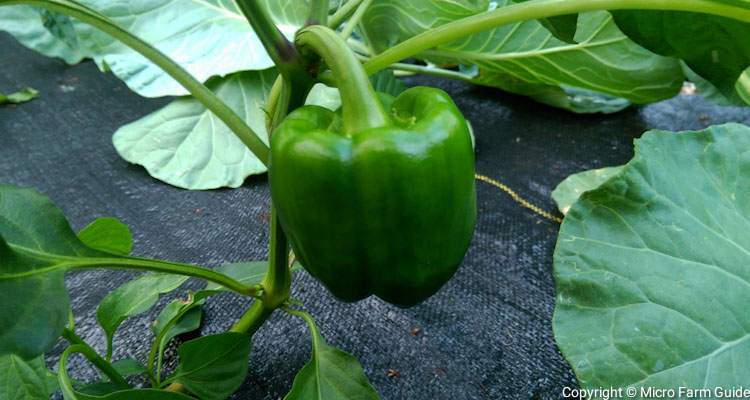
In this article, we will share the exact steps we use to grow bell peppers on our farm and some tips to deal with issues that may arise. Let’s get started!
1. Choose Suitable Varieties For Your Area
Firstly, you can buy sweet pepper seeds online, at department stores, or agriculture centers. These offer a wide variety, especially if you plant in containers.
However, you must ensure that your chosen variety is well-suited to your region if you plan to grow your plants in the ground.
Most local farm centers will carry hybrids that are acclimated to your growing zone, including information on their tolerance to local pests and diseases.
That said, feel free to experiment with exotic varieties. Just ensure that you meet their needs as indicated on their labels.
2. Find A Sunny Location
Pepper plants are sun-loving plants that need 6 to 8 hours of direct sunlight per day to thrive. As a result, you should choose a location where your plants can grow unobstructed throughout the growing season.
Avoid the back of buildings and large trees. Remember, bell pepper plants can live for months, even years. So, you should also consider possible shadows cast at different times of the year.
3. Sow Seeds In Starter Container
Pepper seeds are expensive on our island, so I usually pre-germinate them using the tissue method. Once they sprout, I then place them into individual trays.
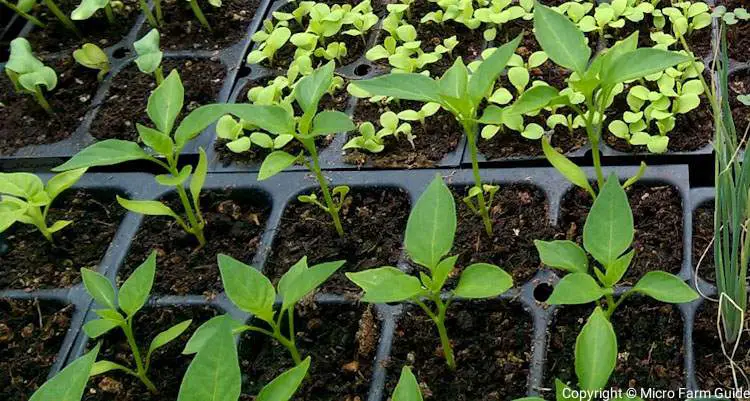
However, you can start green pepper seeds indoors, sowing them directly into a quality seed start or potting mix. To do this:
- Fill the container with a potting mix and then poke 2 holes about ¼ inch deep in each cell.
- Plant 1 seed in each cell, and cover with growing media.
- Water the seeds and place them in a warm dark spot until they germinate.
- Remove seedlings at first sight of sprouting and place them in a well-lit spot.
Green Pepper seeds usually germinate within 10 days when temperatures are over 80°F, but this can be delayed significantly in cooler temperatures. Consider using a warming mat if it is still chilly in your area.
3. Prepare The Soil
Green peppers grow best in fertile, well-drained soils where their roots can move freely. As a result, you should ensure that you amend the soil, especially if it compacts easily.
Sometimes, you’ll need to build raised beds and add organic material such as compost to the top layer. Allow it to break down for a couple weeks before planting.
Alternatively, you can add a thick layer of organic mulch on the surface of the soil the same week you sow the seeds indoors. Water the soil often and you’ll be amazed by the results.
4. Transplant Seedlings Into Pots Or Garden
You can transplant sweet pepper seedlings about 3 to 4 weeks after they germinate, provided the soil temperature is at least 65°F.
Firstly, you will need to dig a hole about the height of the root ball, then place the seedling into the soil and cover. I like loosening the root ball before transplanting, but this is optional.
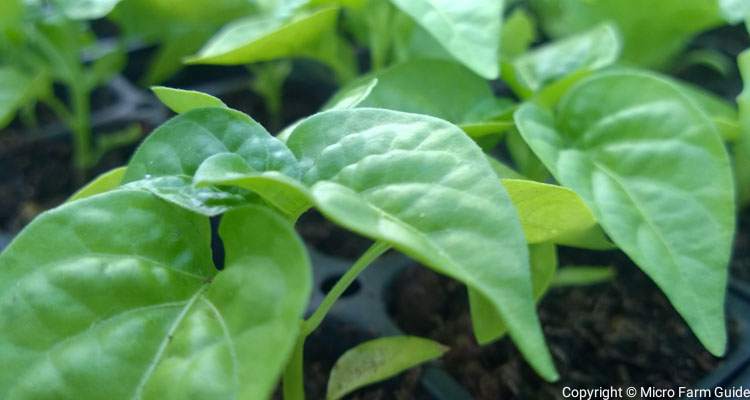
Space plants about 18 inches ( 45 cm) apart and mulch with organic material to help suppress weeds and protect the soil from drying out.
Install trellises and stakes alongside the seedlings, especially if you live in a windy area. This is not necessary with dwarf varieties but can help if your soil is extremely loose.
Water the seedling with a dilute solution of organic fertilizer, such as a mixture of fish emulsion and seaweed. This lessens possible transplant shock and gives the plants a bit of a boost.
5. Water Bell Pepper Plants Regularly
Bell peppers need constant moisture but are susceptible to fungal diseases that can develop in soggy soils.
As a result, you need to ensure that you water your plants regularly and that the soil drains quickly.
Use drip irrigation to conserve water if available. Otherwise, water plants slowly and deeply using a watering can.
I will also suggest that you mulch your plants with a thick layer of organic material to help retain moisture. This will also provide nutrients to the soil as it breaks down.
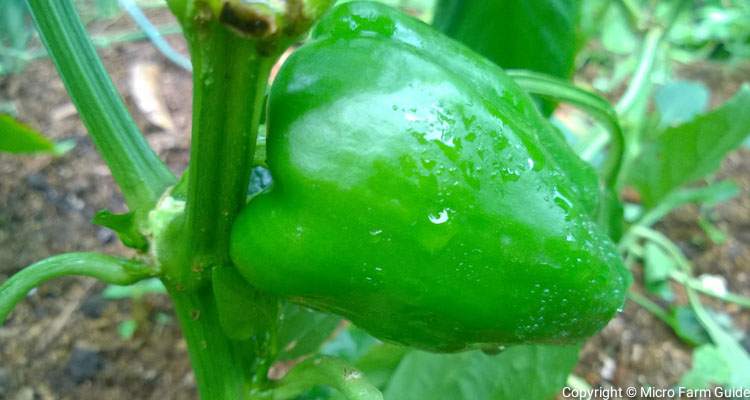
6. Apply Organic Fertilizer
Pepper plants are heavy feeders that require a steady supply of nutrients throughout the growing season.
You should apply a general purpose organic fertilizer when transplanting seedling and every 3 weeks after that.
I like to use a mixture of seaweed and fish emulsion, or other balanced organic fertilizer we make on the farm.
Consider using an organic fertilizer that is formulated for tomato or pepper plants once they start to flower. This will have additional calcium and micro-nutrients needed to support the plant as it produces fruit.
7. Monitor For Pest And Disease
You must monitor your bell pepper plants closely since they attract several pests, including aphids, flea beetles, stem borers, tomato hornworms, and cutworms.
These are seasonal in some areas but are a constant threat here in the tropics. In theory, healthy plants should not attract pests, but most plants will experience some stress, making them perfect targets.
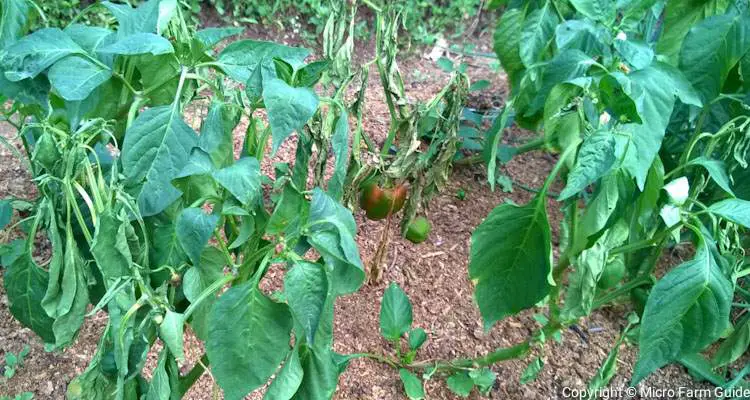
As a result, you should keep an organic pesticide such as neem oil spray or Jadam Organic Pesticide on hand and use it if necessary.
8. Harvest Crops When Green
Generally, you can harvest Bell peppers once they reach the full size and color for their particular variety.
Your bell pepper plants will continue to produce fruit throughout the growing season until they die for one reason or the other.
On average, you can expect 5 to 10 green peppers per plant, with some smaller varieties known to produce as many as 30 bell peppers per plant.
In temperate regions, most sweet pepper plants are grown as annuals. However, they can grow year-round in warmer climates and controlled environments.
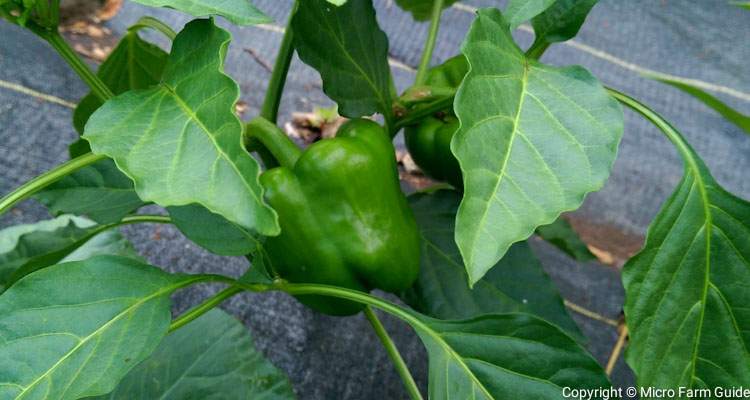
Tips For Growing green peppers in pots
Growing green peppers in pots is easy and necessary where space is limited, or the environment is unsuitable.
To begin, you will need to ensure that you choose the correct container size for the variety of bell peppers you intend to grow.
Typically, you can grow one bell pepper plant in a container that is 18 inches wide and at least 12 inches deep.
You can grow up to 4 green pepper plants in larger containers, such as whisky barrels and tubs, depending on the variety.
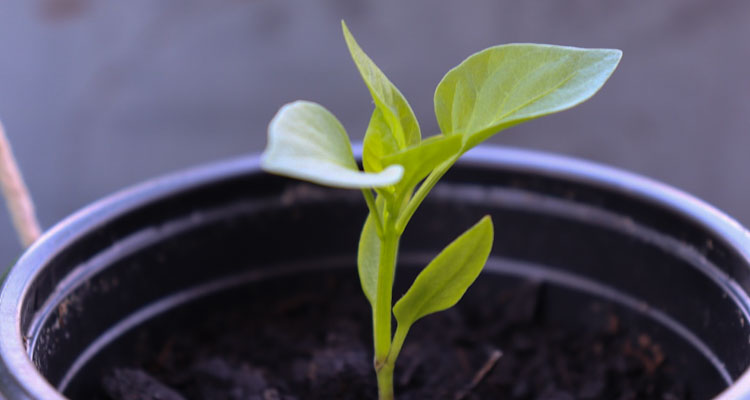
Green peppers grow best in moist soil but are prone to soil-borne diseases, which can develop in soggy soils. As a result, you need to ensure your potting mix drains freely.
Use a good-quality potting mix rich in organic material and additional perlite to improve drainage. You will need to stake larger plants, as they tend to topple over due in part to the loose growing media.
You must ensure you water your plants regularly, especially during dry spells. You can use a drip irrigation system to make this a much easier task.
Bell peppers need at least 6 hours of full sunlight daily and cannot withstand freezing temperatures.
As a result, you will need to carry your plants indoors during winter if you live in a temperate region. Place your pepper plants in a warm sunroom or next to a sizeable sunward-facing window.
How To Improve Bell Pepper Plant’s Lifespan
In theory, bell pepper plants can live up to three years, depending on the variety and growing conditions, with some claims of plants living over 10 years.
However, in our climate, it is difficult to get plants to live over 12 months unless grown inside greenhouses or continuously sprayed with pesticides.
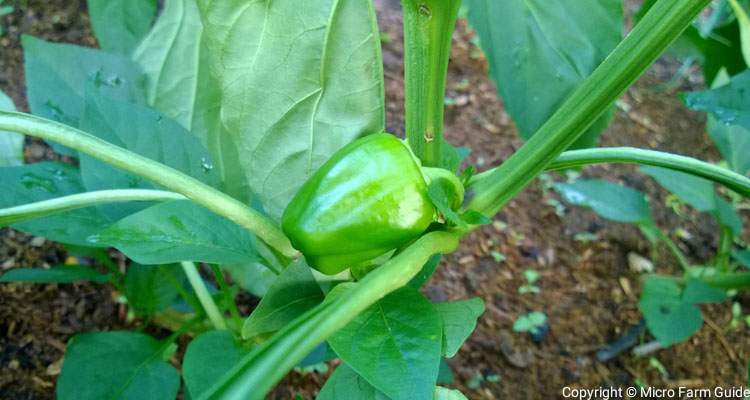
That said, the best way to improve the lifespan of bell pepper plants is to grow them in a climate control structure protected from insects and other sources of disease.
Since this is not always possible, the second best option is to take care of the plant, paying close attention to the growing conditions, monitoring for pests, and pruning when necessary.
Pruning gets rid of dead or dying parts of the plant, encourages the free flow of air, and stimulates new growth. However, its effectiveness depends on the variety and other conditions.
Related Questions
How long does green pepper take to grow?
Green Peppers take 90 to 120 days to grow from seed to harvest, depending on the variety, climate, and other growing conditions. Planting seedlings can reduce this time significantly.
Do green pepper plants need full sun?
Green peppers are sun-loving plants that need 6 to 8 hours of direct sunlight daily for the best growth and performance. However, they can grow in dappled light and partial shade if necessary.
How tall do green pepper plants grow?
Green peppers can grow up to 3 feet tall, depending on the variety and growing conditions. The plant may sometimes surpass this height, requiring additional support to withstand the wind.

